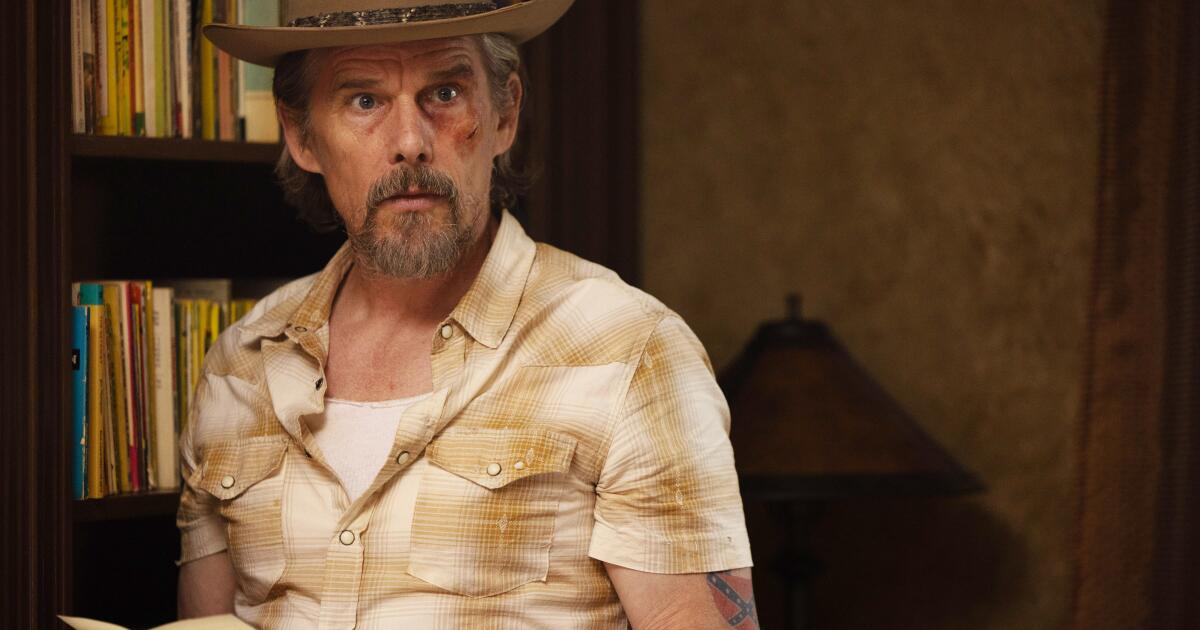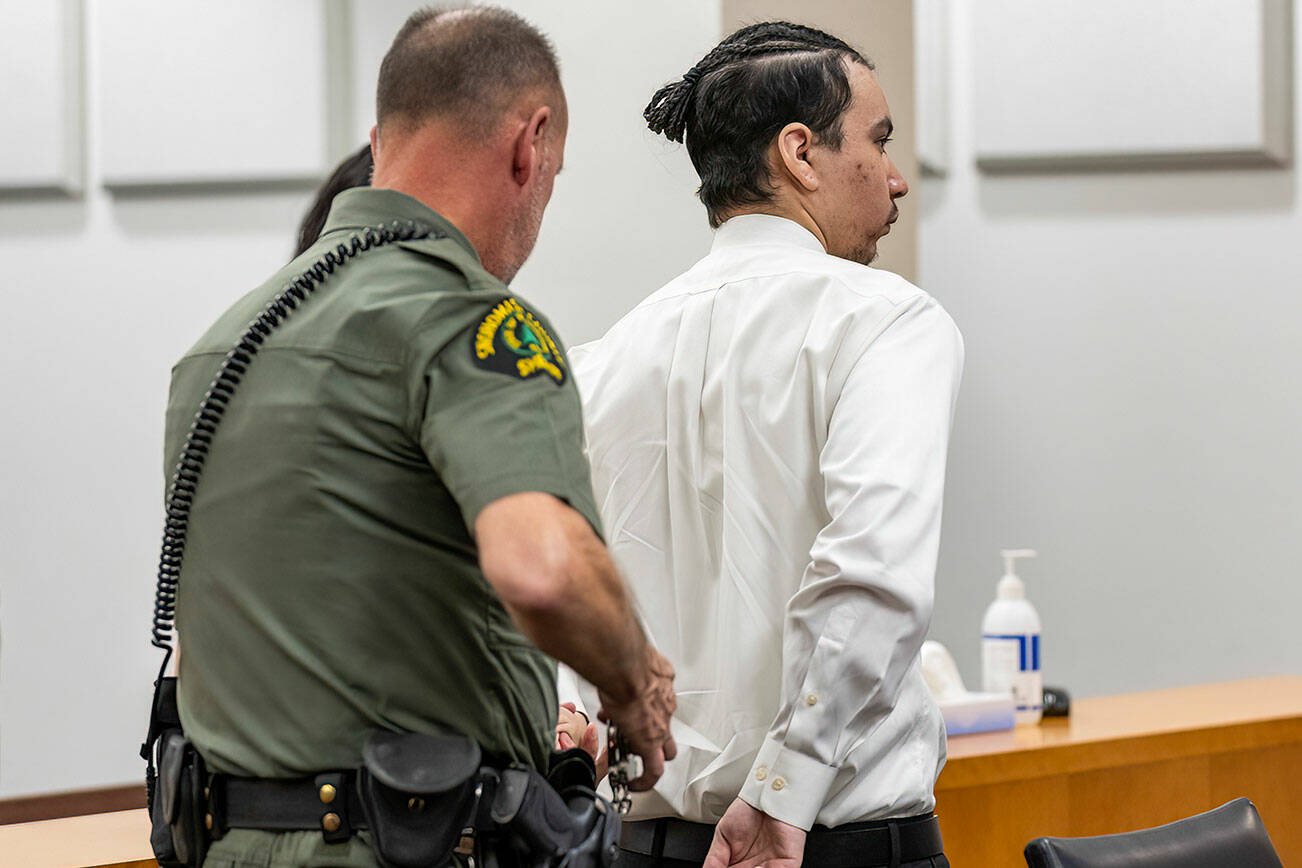
“The Lowdown,” Sterlin Harjo’s new series, after co-creating the brilliant “Reservation Dogs” with Taika Waititi, is a genre exercise — a noir-nodding murder mystery — much as Donald Glover followed “Atlanta,” that show’s aesthetic cousin, with a spy series, “Mr. & Mrs. Smith.” On the face of it, this might seem a step backward. Though genre dominates television production almost to the point of saturation, it may, of course, be done poorly or well, may be obvious or subtle, stale or fresh. The elements may be familiar, but there are only six different pieces in chess, and the combinations are infinite; “The Lowdown,” which premieres Tuesday on FX, wins the game.
We are once again in Oklahoma, off the rez and in the city. Ethan Hawke plays Lee Raybon, introduced on camera by a vape pen and a duct-taped boot. A used-book dealer and self-styled “truthstorian,” whose “true nature” is described by a friend as “narcissistic cowboy with a penchant for seeming like the good guy,” Lee’s character was inspired by Tulsa citizen journalist Lee Roy Chapman, whose article “The Nightmare of Dreamland: Tate Brady and the Battle for Greenwood,” which exposed the racist past of a celebrated citizen, is represented here by Lee’s similar piece on the history of the locally powerful Washberg family. Of his investigative avocation, he says, “I read stuff, I research stuff, I drive around and I find stuff, then I write about stuff. Some people care, some people don’t. I’m chronically unemployed, always broke. Let’s just say that I am obsessed with the truth.”
The series begins with what looks like the suicide — but, naturally, may not be — of Dale Washberg (Tim Blake Nelson), a white sheep in a family of black ones, described in a local newspaper headline as “Eccentric Osage County Man.” (Dale will recur through the series in passages of magical realism, like Dallas Goldtooth’s luckless warrior in “Reservation Dogs.”) Surviving Dale is brother Donald (Kyle MacLachlan), who is running for governor and Dale’s wife, Betty Jo (Jeanne Tripplehorn), who grew up on the wrong side of the tracks and may or may not turn out to be the Barbara Stanwyck in this story.
Lacking an ordinary sense of propriety, Lee attends an estate sale at Dale’s in search of books and finds a note Dale had tucked into a copy of noir idol Jim Thompson’s “Texas by the Tail”; it points to more notes in other crime books, launching a mystery. At the same time, Lee, who has a habit of blithely poking at hornet’s nests and wandering into the lion’s den in search of interesting bones — and pays the price again and again — is looking into fat cat developer Frank Martin (Tulsa native Tracy Letts, who wrote the Pulitzer Prize-winning “August: Osage County”), asking him “why you’re buying up Black-owned businesses around Tulsa — that’s a little weird.” Martin’s statements suggest a coming conflict with the Indigenous population, as he complains to his fellow white-haired white men, “These Indian tribes — they’re like foreign governments set up right here under our nose, beholden to no man and no laws except those of their own making.”
Unlike many lengthy series, which fill time with repetitious reversals of fortune, unproductive subplots and action sequences, “The Lowdown,” like “Reservation Dogs,” uses that real estate to build character and character relationships; it gives its people time to talk. Extended encounters might occupy most of an episode, most notably one with Peter Dinklage as his bitter former partner in the bookshop; both actors make a meal of it.
The dialogue is naturally digressive, sliding in just as much exposition as needed with a magician’s sleight of hand. It’s the sort of show in which Lee’s young teenage daughter and protective sidekick (the marvelous Ryan Kiera Armstrong as Francis), applying makeup to her father’s bruises, will observe that he has “a perfect knuckle-shaped nose,” or in which Lee finds it necessary to explain to a thug attacking him that the article in which he was mentioned wasn’t in a newspaper but a “long-form magazine.” In one episode, featuring a fine performance by John Doe from the band X, he survives by telling a story in order to prove that he’s a writer.
There is a plot here. Only five episodes out of eight were available for review, so I can’t say exactly where it’s going, or if that element of the series will prove worthwhile. But as in “Reservation Dogs,” plot is secondary to character, which in major and minor roles has been beautifully conceived and executed. (You can just sit back and enjoy the people without worrying too much where any of it leads.) Hawke plays his bruised and battered aging hero without a hint of vanity. An impeccable cast features the great Keith David in a nice fat role as a poetical private detective; Kaniehtiio Horn (the Deer Lady in “Reservation Dogs”) as Lee’s ex-wife, Samantha; Michael Hitchcock, a regular in Christopher Guest films, as antique dealer Ray (there’s a little bit of “Lovejoy” in this series as well); Siena East as Lee’s droll bookstore employee, Deidra; and Scott Shepherd as one of those blond bland types whose performative mildness spells danger — along with myriad others whose relatively limited screen time is enough to make a full-bodied impression. That’s what well-written dialogue and good casting can do.
Though the series’ debt to noir fiction and film is foregrounded — as when Marty takes a date to see Robert Wise’s 1949 “The Set-Up” at an art house where the marquee reads “Noir Nights. American Neorealism Series” — “The Lowdown” doesn’t itself quite qualify as noir; it’s too cheeky. It’s certainly no Jim Thompson novel (which can be dark to the point of perversity), but something more akin to Hitchcock in a puckish mood or Robert Altman’s laid-back take on Raymond Chandler’s “The Long Goodbye” — or, for that matter, “The Rockford Files,” in that its protagonist gets worked over a lot, and the bruises show. (Though Jim Rockford’s hair stayed neat in a way that Lee’s refuses to.)
As in “Reservation Dogs,” place is key and roots the action, however extravagant, to the real world. (That show’s director of photography, Mark Schwartzbard, is back at work here, splitting episodes with Christopher Norr.) There are Tulsa-connected musicians on the soundtrack, and a cafe where many conversations, in a highly conversational series, take place, whose name, Sweet Emily’s, references a Leon Russell song and Emily Smith, the woman it celebrates. There are many other nods to local culture and history you are certainly not expected to recognize — but can feel cool if you do. The important thing is to watch.



